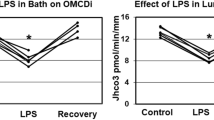Summary
Hyperosmolority in the urinary tract inhibits the host defense against bacterial infection. NaCl contributes most to osmolority in the renal medulla and urine. Therefore, we studied the effect of hyperosmolar NaCl on neutrophil function. When osmolarity was increased by NaCl, polymorphonuclear leukocytes (PMNL) became defective in phagocytosis, intracellular killing of bacteria, chemotactic activity, and superoxide production. This coincided with a decrease in the intracellular adenosine triphosphate (ATP) content of PMNL. Both the inhibition of superoxide production and the reduction in ATP content did not occur at 4°C. By increasing ATP content, phosphoenol pyruvic acid (PEP) protected against the decrease in superoxide production. These results suggest that leukocyte function is inhibited by high concentrations of NaCl due to the activation of the Na+−K+ pump. PEP, an ATP precursor, can protect PMNL against osmotic stress by raising the intracellular concentration of ATP.
Similar content being viewed by others
References
Babior BM, Cohen HJ (1981) In: Cline MJ (ed) Methods in hematology, vol 3. Churchill Livingstone, London
Bonnet B, Matsumoto T, Husson M, Van der Auwera P (1987) Influence of osmoprotectants on superoxide generation by human neutrophils submitted to high osmolarity. Arch Int Physiol Biochem 95:S 1
Hamasaki N, Hardjono IS, Minakami S (1978) Transport of phosphoenol pyruvate through the erythrocyte membrane. Biochem J 170:39
Hamasaki N, Ideguchi H, Ikehara Y (1981) Regeneration of 2,3-bisphophoglycerate and ATP in stored erythrocytes by phosphoenol pyruvate: a new preservative for blood storage. Transfusion 21:391
Leijh PCJ (1979) Kinetics of phagocytosis of Staphylococcus aureus and Escherichia coli by human granulocytes. Immunology 37:453
Leijh PCJ (1980) Kinetics of intracellular killing of Staphylococcus aureus and Escherichia coli by human granulocytes. Eur J Immunol 10:750
Macknight ADC, Leaf A (1977) Regulation of cellular volume. Physiol Rev 57:510
Matsumoto T, Bonnet M, Husson M, Kumazawa J, Van der Auwera P (1988) Effect of NaCl and urea concentration comparable to renal medulla on superoxide production by human polymorphonuclear leukocytes. Urol Res 16:367
Matsumoto T, Kumazawa J, Van der Auwera P (1989) Suppression of leukocyte function and intracellular content of ATP in hyperosmotic condition comparable to the renal medulla. J Urol 142:399
Nakao M, Nakao T, Tatibana M, Yoshikawa H, Abe T (1959) Effect of inosine and adenine in adenosine triphosphate regeneration and shape transformation in long-stored erythrocytes. Biochem Biophys Acta 32:564
Synderman R, Pike MC (1978) Methodology for monocyte and macrophage chemotaxis. In: Gallin JI, Quie PG (eds) Leukocyte chemotaxis, Raven, New York
Author information
Authors and Affiliations
Rights and permissions
About this article
Cite this article
Matsumoto, T., van der Auwera, P., Watanabe, Y. et al. Neutrophil function in hyperosmotic NaCl is preserved by phosphoenol pyruvate. Urol. Res. 19, 223–227 (1991). https://doi.org/10.1007/BF00305299
Accepted:
Issue Date:
DOI: https://doi.org/10.1007/BF00305299




